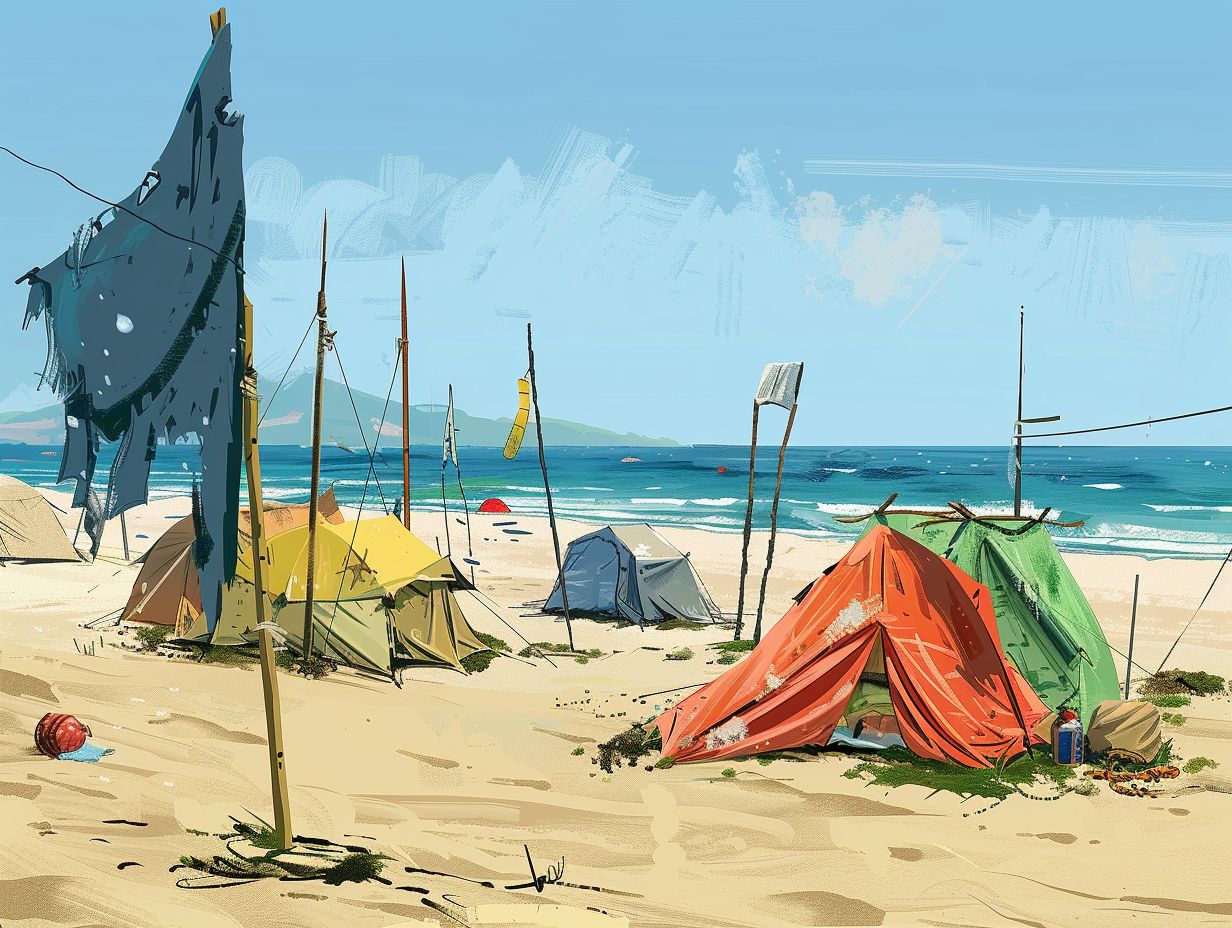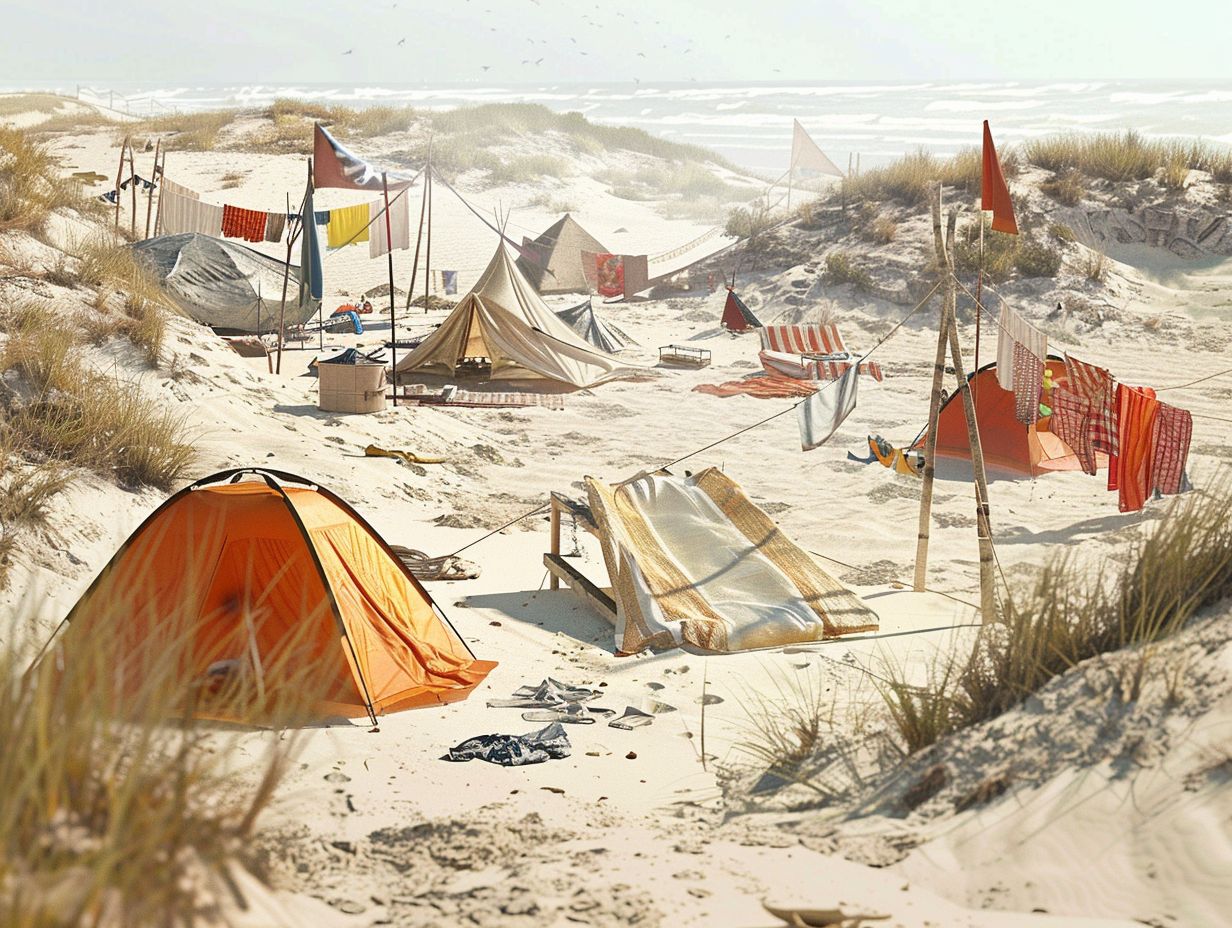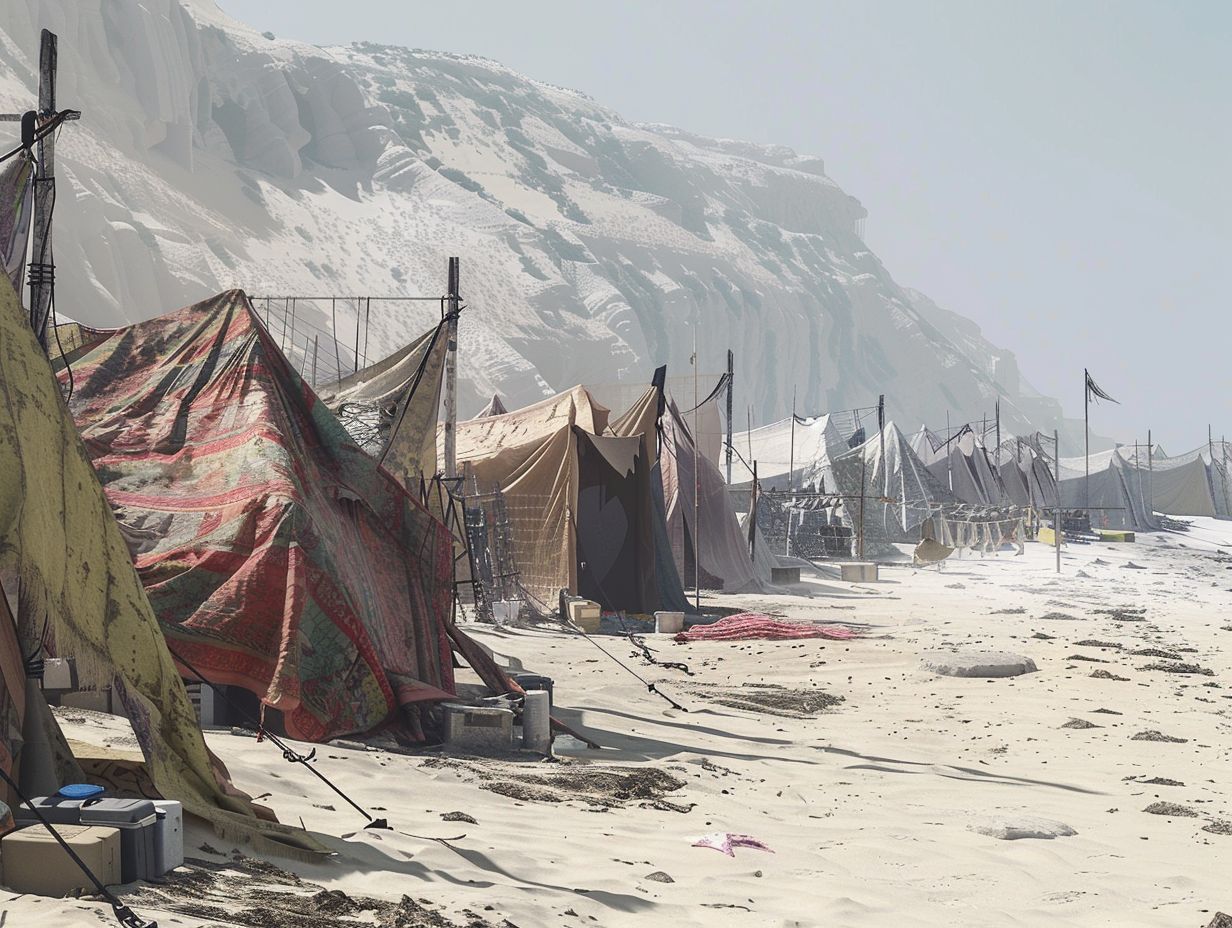Are you tired of battling the wind while trying to relax on the beach during your camping trip? In this article, you will explore the benefits of using a windbreak for beach camping, factors to consider when choosing the best one, and the top types of windbreaks available.
From pop-up canopies to DIY options, you will be covered. Learn tips on setting up your windbreak, securing it in windy conditions, and maintaining it for long-lasting use. Say goodbye to wind-swept picnics and hello to a peaceful beach camping experience!
Key Takeaways:

- Protect yourself from strong winds and enjoy a more comfortable beach camping experience by using a windbreak.
- Consider factors such as size, material, and ease of set-up when choosing the best windbreak for beach camping.
- The best windbreaks for beach camping include pop-up canopies, beach tents, umbrellas, windscreens, inflatable windbreaks, and even DIY options.
Benefits of Using a Windbreak for Beach Camping
Using a wind break during your beach camping trip will offer vital protection from the wind, ensuring a pleasant outdoor experience for you, your family, and your pets. The inclusion of a wind break not only shields you from strong wind gusts but also establishes a secluded area where you can relax undisturbed.
Imagine arranging your camping stove behind the wind break, enabling you to cook peacefully without having to contend with the relentless wind.
Wind breaks create a cosy atmosphere for relaxing, allowing you to enjoy a peaceful evening outdoors without feeling fully exposed to the elements. The security and comfort provided by wind breaks can significantly enhance the overall enjoyment of your camping adventure.
Factors to Consider When Choosing a Windbreak
When selecting a windbreak for beach camping, you should consider several factors.
- First, think about the level of privacy the windbreak offers. It is important to assess whether it provides sufficient coverage to shield your campsite from prying eyes.
- Next, consider the durability of materials. Look for options made from sturdy, weather-resistant materials that can withstand coastal conditions.
- Additionally, pole stability is crucial for windy beach settings. Opt for windbreaks with strong, durable poles that can withstand gusts.
- Height is another important factor to consider, as taller windbreaks offer more coverage and protection.
- Finally, anchoring capabilities are vital for keeping the windbreak securely in place. Make sure the stakes or anchors provided are robust enough to withstand strong seaside winds.
By evaluating these factors, you can select a windbreak that meets your needs for beach camping.
The Best Types of Windbreaks for Beach Camping
When selecting windbreaks for your beach excursions, various options are available to cater to different types of beach terrains. Fibreglass models are recommended for their lightweight portability, making them easy to set up and transport. These windbreaks are convenient for carrying on hikes to remote beaches or camping sites.
Alternatively, canvas windbreaks provide enhanced durability, making them suitable for more exposed coastal areas that are prone to strong winds. The choice between fibreglass and canvas windbreaks depends on the frequency of use and the conditions in which they will be utilised.
Along with the material, the dimensions of the windbreak are essential in ensuring adequate coverage. Smaller windbreaks are suitable for solo adventurers or couples, while larger ones can accommodate families or groups seeking shelter from the wind. Consider the dimensions and material of the windbreak carefully to meet your specific camping needs.
Pop-Up Canopy
A pop-up gazebo can serve as an excellent windbreak on sandy beaches, providing protection from sand and dirt. These gazebos are designed with durable materials like nylon or polyester, making them both windproof and portable shelter solutions.
The design of pop-up gazebos makes them particularly well-suited for beach camping. Their quick set-up and take-down process eliminates hassle, while their lightweight construction allows for easy transportation.
This makes pop-up gazebos an ideal choice for outdoor enthusiasts seeking to enjoy a day at the beach without being hindered by the elements. The nylon or polyester construction of these gazebos also offers UV protection, ensuring a safe and shaded area for relaxation under the sun.
Additionally, adjustable heights and anchoring options provide versatility in shielding against windy conditions at the beach.
Beach Tent

A beach tent serves as both a windbreak and a private cooking space, boasting sand-proof construction, lightweight materials, and sturdy steel frames to endure beach conditions.
Thanks to their innovative design, these versatile beach tents offer a practical solution for beachgoers in need of shelter from the wind while also creating a designated area for cooking activities. The sand-proof fabric ensures that the tent remains free of sand, providing a clean and enjoyable experience.
The use of lightweight materials makes them easy to transport and set up, making them ideal for a quick beach getaway. The steel components offer excellent durability and stability, ensuring the tent can withstand strong winds and frequent use over time.
Beach Umbrella
When looking for a windbreak option for your beach camping setup, consider using a beach umbrella. Available in various sizes and dimensions, beach umbrellas provide protection from the sun and wind while adding a colourful and portable element to your beach experience.
These versatile windbreaks are designed in a range of vibrant colours to allow beachgoers to express their personal style or stand out on the beach.
From compact, lightweight designs suitable for solo travellers to larger canopies ideal for family gatherings, there is a beach umbrella to meet every requirement. The portability of these umbrellas enables you to set up your windbreak wherever you choose, creating a sheltered spot to relax and enjoy the seaside breeze.
Whether you prefer a bold and eye-catching umbrella or a more understated, classic design, beach umbrellas offer a combination of style and functionality for a comfortable day by the shore.
Windscreen
A windscreen offers a reliable windbreak solution that is specifically designed to be windproof. Available in various sizes, it provides optimal privacy and protection from strong beach winds. The windproof design of windscreens ensures they effectively block out the wind, creating a sheltered area for beach campers.
These screens are available in different sizes to cater for individual privacy preferences, whether one prefers a more open layout or a secluded setting.
By acting as a barrier against gusts of wind, windscreens significantly enhance the comfort level of your beach camping experience, allowing you to relax and enjoy the seaside without the constant disturbance of strong winds.
Inflatable Windbreak
A durable plastic inflatable windbreak offers a convenient shelter solution that is simple to set up, including anchor stakes and guy lines for secure installation on the beach. The plastic material used in these windbreaks guarantees longevity whilst keeping them lightweight and easy to transport.
The anchor stakes provide a secure hold for the windbreak, and the guy lines add extra stability, ensuring peace of mind for users even in windy conditions. The straightforward setup process reduces the time spent dealing with complex instructions, allowing for more time to relax by the seaside.
Beach Towel Windbreak
A beach towel windbreak provides a lightweight and portable privacy solution, ideal for creating a comfortable beach camping setup. It often includes a convenient carry case for effortless transportation.
The straightforward design and practicality of these windbreaks make them an essential item for beach enthusiasts seeking a fast and efficient method to establish privacy while basking in the sun and sand.
When camping on the beach, having a dedicated space shielded from curious onlookers can greatly enhance your overall experience. The added convenience of a carry case ensures that you can easily pack up your windbreak and move to your next picturesque beach location without any difficulty.
DIY Windbreak

Constructing a DIY windbreak allows you to customise it at a lower cost, providing a personalised solution tailored to your camping needs. Utilising a comprehensive buying guide can assist you in acquiring the necessary materials and tools for the project.
This approach not only results in cost savings but also provides you with the satisfaction of crafting a solution that meets your specific requirements. By choosing a DIY windbreak, you have the opportunity to select materials that match your style and preferences, ensuring a distinctive and functional final product.
Engaging in this hands-on project can be a fulfilling endeavour, fostering a stronger connection to your camping setup. Equipped with the appropriate materials and tools, you can confidently undertake this project, knowing you are creating something customised for your outdoor adventures.
Tips for Setting Up a Windbreak on the Beach
To set up your windbreak effectively on the beach, ensure proper installation by securing it in the sand with anchor stakes, adjusting for windproof stability, and utilising guy lines to maintain tension and prevent shifting.
- Begin by finding a suitable location on the beach with enough space to set up your windbreak without obstruction.
- Once you have selected the spot, drive the anchor stakes into the sand at an angle, aiming away from the wind direction for maximum stability. Make sure to place the stakes deep enough to provide secure anchoring.
- Next, attach the guy lines to the windbreak and stretch them out, securing them firmly in the sand using additional stakes or sandbags as needed. This extra reinforcement will help withstand strong gusts.
- Regularly monitor the wind conditions and adjust the tension of the guy lines accordingly to keep your windbreak firmly in place.
How to Secure Your Windbreak in Windy Conditions
In windy conditions, you should secure your windbreak effectively by reinforcing anchor stakes, adjusting the angle to minimise wind resistance, and using additional guy lines for extra support to prevent toppling or shifting.
When setting up your windbreak in loose sand, you should consider reinforcing anchor stakes by driving them deeper into the ground to provide a stronger hold.
Positioning the structure parallel to the prevailing wind direction can also help reduce the force it experiences. Adding guy lines and tensioning them properly can enhance the stability of the windbreak by distributing the stress evenly.
These strategies combined create a sturdy defence against strong gusts, ensuring your windbreak remains intact and functional during windy weather.
Maintenance and Care for Your Windbreak
To maintain your windbreak, it is important to regularly clean it to eliminate sand, dirt, and debris. This practice is essential for ensuring the windbreak’s longevity and optimal performance during your future beach camping trips.
Regular cleaning of your windbreak is critical to prevent the buildup of damaging elements such as salt, which can lead to corrosion over time.
When cleaning a fabric windbreak, the recommended approach is to use a mild detergent mixed with water and gently scrub the surface with a soft brush. For wooden windbreaks, a mixture of water and vinegar is effective in removing mould and mildew.
After cleaning, it is important to ensure thorough drying before storing the windbreak to prevent musty odours or mildew growth. Storing windbreaks in a dry, well-ventilated area, away from direct sunlight, is key to preserving their quality for the seasons to come.
Alternatives to Windbreaks for Beach Camping
When considering options beyond traditional windbreaks for creating a sheltered and private space on the beach, alternative solutions such as lightweight privacy screens, canopy tents, or umbrellas can offer versatility in material choices and setup.
Privacy screens present an excellent choice for individuals seeking to block wind while still maintaining visibility. These screens are available in various styles and materials, such as mesh or cloth, to cater to different preferences.
Canopy tents provide a larger covered area, delivering protection from both sun and wind. They are constructed from waterproof materials like polyester or nylon, making them well-suited for extended stays.
Conversely, umbrellas offer a convenient solution for rapid setup and portability, with options ranging from compact beach umbrellas to robust, wind-resistant models.
Frequently Asked Questions

What are the benefits of using windbreaks for beach camping?
Windbreaks provide shelter and protection from strong winds, creating a more comfortable camping experience. They also help to keep sand and debris from blowing into your campsite.
What should I consider when choosing the best windbreak for beach camping?
When choosing a windbreak for beach camping, consider the material, size, and weight. Look for a lightweight and durable material that can withstand strong winds and is easy to set up. The size should be large enough to provide adequate coverage for your camping area.
What are the most common types of windbreaks for beach camping?
The most common types of windbreaks for beach camping are traditional poles and fabric windbreaks, inflatable windbreaks, and beach tents that can function as windbreaks.
Do I need to anchor my windbreak when camping on the beach?
Yes, it is recommended to anchor your windbreak when camping on the beach to ensure it stays in place and provides adequate protection. This can be done using sandbags or stakes designed for beach camping.
Can I use a beach umbrella as a windbreak for beach camping?
Beach umbrellas can provide some protection from the wind, but they are not as effective as a dedicated windbreak. They are also not as sturdy and may not withstand strong winds, making them less reliable for beach camping.
How do I properly set up and secure my windbreak on the beach?
To set up and secure your windbreak on the beach, first determine the direction of the wind and position the windbreak accordingly. Use stakes or sandbags to anchor the windbreak at all corners and along the bottom edge. Pull the fabric taut and adjust the stakes as needed to ensure the windbreak is secure.



